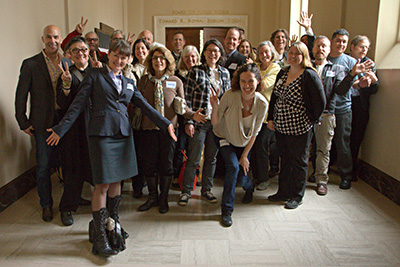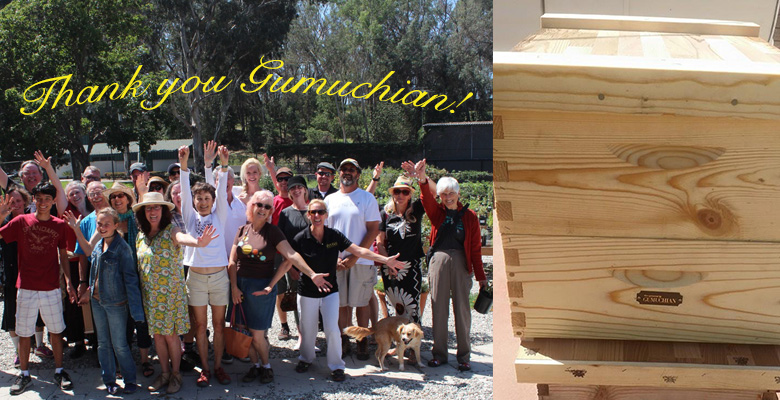Click here to view full press release and photo

Photo by Karim Sahli
LA Planning Commission unanimously approves backyard beekeeping ordinance today.
After years of public outreach and grassroots efforts[1] at the local community councils led by beekeepers across Los Angeles, the Department of City Planning, Policy Division[2] presented its recommendations for backyard beekeeping to the LA Planning Commission today and received unanimous support.
In addition to the swarm of local beekeeping supporters who all spoke in favor of legalizing backyard beekeeping, Councilmember Paul Koretz (CD-5), Clare Eberle, planning deputy for Councilmember José Huizar (CD-14), and former Culver City Mayor Meghan Sahli-Wells were also in attendance speaking in favor of the ordinance.
LA City Councilmember Paul Koretz surprised the Planning Commission by showing up to testify. “There is no one more nervous about bees than I am. I stepped on a bee years ago, got stung, my leg swelled up and I had to walk with a cane for three weeks,” Koretz said. “There are currently 9 to 11 beehives per square mile in Los Angeles. When this ordinance passes, there will remain 9 to 11 beehives per square mile, but we will have more beekeepers to know where they are and to manage those hives. Which is a great idea in my book.”
“Bees are an essential part of our food system. According to the USDA, bees are responsible for the production of about a third of our diet. In addition, bees are a boon to local gardeners and urban farmers. As you may be aware, honeybees worldwide are in crisis, falling prey to the mysterious Colony Collapse Disorder at an alarming rate, making beekeeping a serious food security issue.” – Rob McFarland, Los Angeles Resident (Co-Founder of HoneyLove)
NY Times just reported on May 13, 2015: “Since April 2014, beekeepers lost 42.1 percent of their colonies, the second highest loss rate in nine years, according to an annual survey conducted by a bee partnership that includes the U.S. Department of Agriculture.”[3]
“Hunger is a huge problem in our city. Currently, there are over 1.1 million citizens using the SNAP program for food assistance. Honeybees are such effective pollinators that they are able to increase agricultural yield by 30 to 60 percent. A 30 to 60 percent increase in productivity in an urban garden can mean the difference between a family needing food assistance and a family who can pull themselves out of poverty, and even participate in a local, green economy! Urban beekeeping is a powerful tool that we can use to help provide food security for our most vulnerable neighbors. Honeybees enable people of all economic levels to eat better and have the empowering and deeply satisfying experience of successfully growing their own food.” – Max Wong, Los Angeles Resident
Most cities have already legalized urban beekeeping including Santa Monica, Redondo Beach, Culver City, San Diego, San Francisco, New York, Seattle, Portland, Denver, Chicago, Toronto, Vancouver, Paris, London… the list goes on.
“It’s great to see Los Angeles catching up with all the other great cities of the world in making beekeeping legal. The City Planning department did a great job in crafting a common sense set of regulations. Once the City Council approves the changes to the code we can get on with the work of saving bees and creating a city friendly to pollinators.” – Erik Knutzen, Los Angeles Resident
“The most common concern about honey bees is bee stings. Honey bees are not aggressive by nature and are unlikely to sting. Only 0.4% of Americans report an allergy to insect stings in the U.S., and almost none of these are caused by honey bees. In addition, less than 1% of the US population is at risk of systemic reaction to stings by honey bees. Severe reactions from the sting of any one insect in a year are 1 in 5,555,556. The chance that someone will be hit by a car is 59.3% higher.”[4]
“There are so many environmental reasons to support urban beekeeping but there is also a really critical safety element. When beekeeping is legal, then feral hives can be properly managed which makes our city safer.” – Meghan Sahli-Wells, Current Councilmember and former Mayor of Culver City
“I am one of the minuscule percentage of people who is actually systemically allergic to honey bees and I am full support of legalizing urban beekeeping in Los Angeles. Beekeepers are our first line of defense in helping to make the city safer by managing the feral populations of bees that already live naturally in our environment. I am very happy to see this ordinance move forward!” – Chelsea McFarland, Los Angeles Resident
“I am a registered urban beekeeper with two boys 4 and 8 years old who have NEVER been stung by any honey bees from our two managed hives in our backyard. Unlike the 9 to 11 unmanaged feral hives already existing per square mile in Los Angeles[5], my hives are managed and carefully looked after. Having more educated beekeepers will in fact provide a safer environment for everyone.” – Paul Hekimian, Santa Monica Resident
[1] http://honeylove.org/press/
[2] Planning Department: Spearheaded by Katherine Peterson and supervisors Tom Rothmann and Erick Lopez, and Student Professional Worker, Jaime Espinoza.
[3] http://www.nytimes.com/aponline/2015/05/13/science/ap-us-sci-bee-deaths.html?ref=aponline&_r=1
[4] http://justfood.org/sites/default/files/Just%20Food%20Beekeeping%20Campaign%20Fact%20Sheet.pdf
[5] 9-11 colonies of bees per square mile was a stat given by LA County Agricultural Commissioner during the Mar Vista Beekeeping Feasibility Study in 2011 – https://docs.google.com/file/d/0B3mjhYhHhzMrNGRiYjkzNjItMGExNi00Y2I1LWIyMWUtY2VhYTIwNzJkMTQ5/edit
About HoneyLove
HoneyLove is a Los Angeles based 501(c)3 non-profit conservation organization with a mission to protect the honeybees by educating our communities and inspiring new urban beekeepers. Founded in 2011, HoneyLove believes that the city is the last refuge of the honeybee. Our home gardens are generally free of pesticides, and in cities like Los Angeles, there is year-round availability of pollen and nectar for the honeybees! Learn more about HoneyLove’s events and services at http://honeylove.org


 follow
follow  watch
watch  subscribe
subscribe 
















 Become a member of HoneyLove and learn to be an urban beekeeper!
Become a member of HoneyLove and learn to be an urban beekeeper!
 Plant an organic garden without the pesticides that harm honeybees!
Plant an organic garden without the pesticides that harm honeybees!
 Provide a water source on your property – bees love clean water to drink!
Provide a water source on your property – bees love clean water to drink!